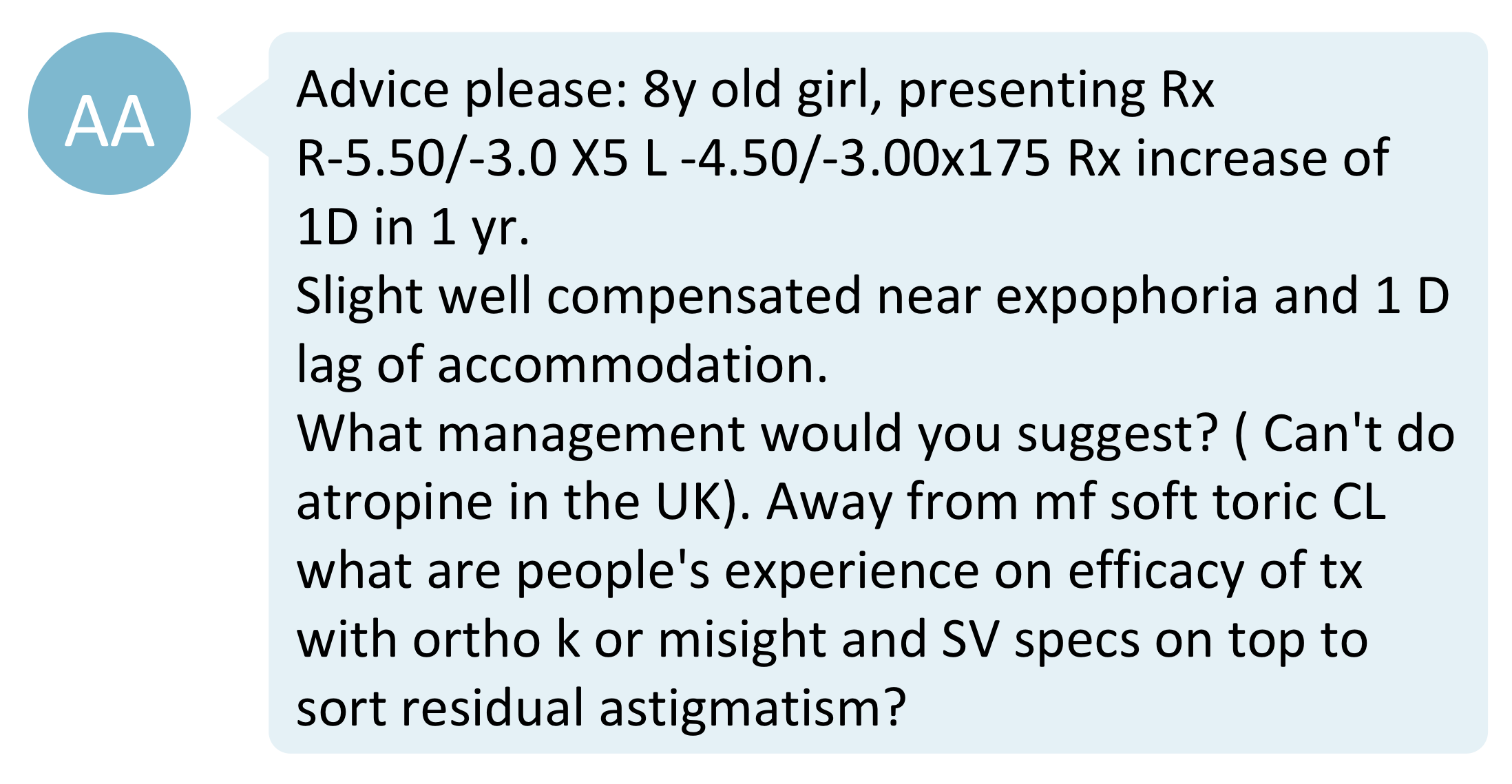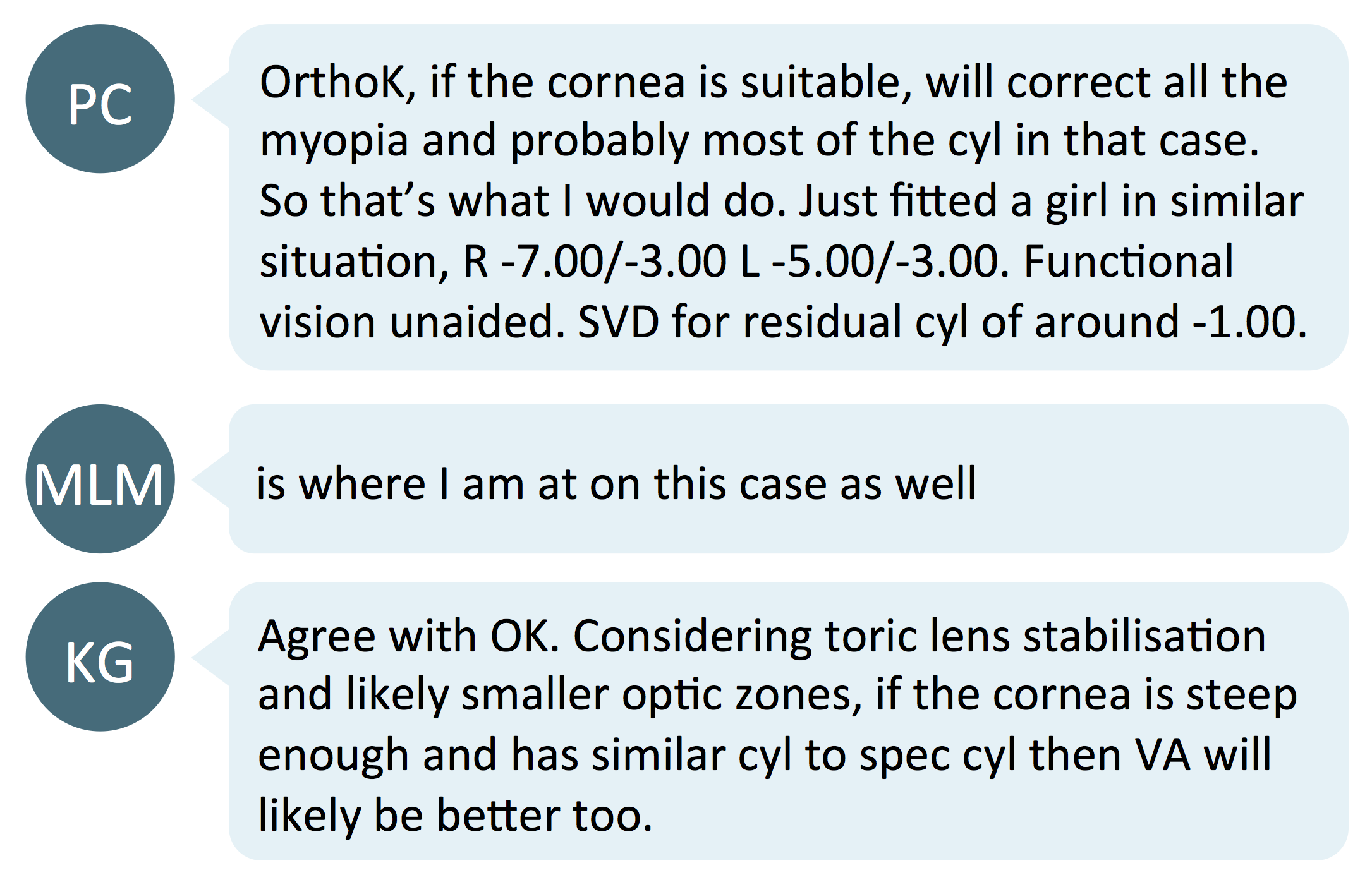The benefit of optical treatments for myopia are that they both correct refractive error and control progression. Here we have a case involving an astigmatic myope presented by AA on the Myopia Profile Facebook group.

Option 1: orthokeratology

Most commenters suggested fitting orthokeratology lenses. There are two key reasons to consider orthokeratology:
- Full correction of astigmatism is possible, if the refractive and corneal astigmatism are similar
- Orthokeratology (OK) is the only optical intervention for which there is evidence of myopia control in higher levels of astigmatism. Toric OK for myopes with astigmatism up to 3.50DC appears to be just as effective for myopia control as spherical OK for myopes with minimal astigmatism.1-3 The Menicon Bloom Night Toric lens was the first for which this efficacy in controlling myopia with moderate to high astigmatism was demonstrated.1
A simple rule-of-thumb for OK fitting is that the refractive astigmatism should not exceed the corneal astigmatism by more than 0.75D. Since OK only corrects astigmatism on the cornea, any additional refractive astigmatism will be likely to be residual after treatment. This is an important rule for beginner and intermediate OK fitting eye care practitioners; experienced OK fitters using specific designs may be able to manage corneal-to-refractive astigmatism mismatch to still achieve a good visual outcome for the patient.
Option 2: soft contact lenses

If OK is not a suitable choice for the patient or their family, soft contact lens options could be considered. This may be required if the patient's refractive and corneal astigmatism are not in close alignment.
The CooperVision MiSight 1 day contact lens, as mentioned in the comment, appears to show similar myopia control efficacy to OK,4 but only children with up to 0.75D of astigmatism were included in the clinical trial.5
For this patient, fitting MiSight 1 day would mean that the full astigmatism amount would need to be corrected with spectacles, worn over the contact lenses. As mentioned by KG, the child and parent would need to understand the imperative to wear the astigmatism-correcting spectacles PLUS the soft contact lenses. To not wear the spectacles whilst wearing the glasses could both impede reading and learning performance6 as well as lead to more myopia progression due to undercorrection.7
Option 3: atropine

As this patient is 8 years of age and hence in the time of fastest progression (between 7 and 10 years of age),8 it is worthwhile considering the combination of atropine with an optical intervention. Orthokeratology again holds a special distinction here, as the only intervention for which increased efficacy when combined with low-concentration atropine has been shown.9
One meta-analysis of primarily 0.01% atropine combined with OK showed a mean 0.25mm axial elongation in a year, compared to 0.35mm in OK alone, giving a mean difference of 0.09mm additional efficacy provided by the combination.9 The longest clinical study of 0.01% atropine combined with OK, though, showed a significant effect only for 1-3D myopes and not for 3-6D myopes.10 In atropine monotherapy, stronger concentrations of 0.025% to 0.05% appear to be needed to achieve effective myopia control.11 This concentration-dependent efficacy has not been investigated or demonstrated when atropine is used in combination with OK.
Considering this patient has spherical component of myopia of R -5.50D and L -4.50D, the combination may not be effective. Monotherapy with OK alone could be considered first, and combination treatment could be discussed at the outset for parental informed choice or considered based on future outcomes.
Considering more than myopia control
Orthokeratology has the largest volume of evidence for myopia control - as arguably the first optical intervention to show a significant impact for slowing myopia progression, back in 2005,12 there are simply more studies on OK which have been published since compared to other treatments. The evidence for soft contact lens options, so far, indicates that the MiSight is likely to have similar efficacy to OK while other multifocal options may have slighly lower efficacy.4
In addition to efficacy, though, it's important to consider what is going to best suit the patient. This case highlights the example of astigmatism, for which the best monotherapy could likely be achieved with OK. There are numerous other considerations in comparing the practicalities and wearer experience of both options, which are important to discuss with the patient and their parent(s). The table below provides a brief summary.
| Orthokeratology | Soft contact lenses | |
| Wearing schedule | Worn to sleep
Only worn at home |
Worn during waking hours
Worn to locations outside the home |
| Benefits | Clear vision through the day without optical aids
Best option for water sports and other sports / activities where debris could reach the eye (eg. gymnastics, football) May be better for dry eye and ocular allergies Can correct higher levels of astigmatism |
Can be worn part time
Best option if there is concern about lens handling, loss or breakage Daily disposables are safest; reusable soft lenses have similar safety to OK Simple for practitioner to fit Simple for patient to maintain (especially daily disposables) |
| Considerations | Must be worn full time
More complex to fit, requiring a topographer Take more time for patient to clean and maintain lenses |
Need up-to-date back up glasses for regular use, when contact lenses are removed
Limited options for astigmatism Not recommended for water sports |
| Replacement schedule | By practitioner discretion or as recommended by manufacturer: typically 6-12 monthly | Daily or monthly depending on the lens type |
Take home messages
- Orthokeratology has a large volume of evidence for myopia control and the only evidence for myopia control with astigmatism up to 3.50D.
- Consider what best suits the patient and their family as well as selecting the best option for myopia control
- Combining atropine (typically 0.01%) with orthokeratology has evidence for an additive myopia control effect, but this might be most effective in lower myopes under 3D.
Further reading on orthokeratology
-
Is orthokeratology useful for myopia control in low myopia?
-
Clinical case: Fitting orthokeratology successfully for a patient with astigmatism
-
Clinical case: Getting parents onboard with orthokeratology
If you'd like to get started fitting orthokeratology yourself, check out our Myopia Profile Academy online course Orthokeratology Fundamentals, which is structured to step you through your first handful of fits with safety and success.

About Kimberley
Kimberley Ngu is a clinical optometrist from Perth, Australia, with experience in patient education programs, having practiced in both Australia and Singapore.

About Connie
Connie Gan is a clinical optometrist from Kedah, Malaysia, who provides comprehensive vision care for children and runs the myopia management service in her clinical practice.
This content is brought to you thanks to an unrestricted educational grant from
![]()
References:
- Chen C, Cheung SW, Cho P. Myopia control using toric orthokeratology (TO-SEE Study). Invest Ophthalmol Vis Sci 2013;54:6510-7. (link)
- Luo M, Ma S, Liang N. Clinical efficacy of toric orthokeratology in myopic adolescent with moderate to high astigmatism. Eye Sci 2014;29:209-13,218. (link)
- Lyu B, Hwang KY, Kim SY, Na KS. Effectiveness of Toric Orthokeratology in the Treatment of Patients with Combined Myopia and Astigmatism. Korean J Ophthalmol 2016;30:434-42. (link)
- Morgan PB, Murphy PJ, Gifford KL, Gifford P, Golebiowski B, Johnson L, Makrynioti D, Moezzi AM, Moody K, Navascues-Cornago M, Schweizer H, Swiderska K, Young G, Willcox M. CLEAR - Effect of contact lens materials and designs on the anatomy and physiology of the eye. Cont Lens Anterior Eye. 2021 Apr;44(2):192-219. (link)
- Chamberlain P, Peixoto-de-Matos SC, Logan NS, Ngo C, Jones D, Young G. A 3-year Randomized Clinical Trial of MiSight Lenses for Myopia Control. Optom Vis Sci. 2019;96(8):556-67. (link) [link to Myopia Profile paper review]
- Narayanasamy S, Vincent SJ, Sampson GP, Wood JM. Simulated astigmatism impairs academic-related performance in children. Ophthalmic Physiol Opt. 2015 Jan;35(1):8-18. (link)
- Logan NS, Wolffsohn JS. Role of un-correction, under-correction and over-correction of myopia as a strategy for slowing myopic progression. Clin Exp Optom. 2020 Mar;103(2):133-137. (link)
- Chua SY, Sabanayagam C, Cheung YB, Chia A, Valenzuela RK, Tan D, Wong TY, Cheng CY, Saw SM. Age of onset of myopia predicts risk of high myopia in later childhood in myopic Singapore children. Ophthalmic Physiol Opt. 2016 Jul;36(4):388-94. (link)
- Gao C, Wan S, Zhang Y, Han J. The Efficacy of Atropine Combined With Orthokeratology in Slowing Axial Elongation of Myopia Children: A Meta-Analysis. Eye Contact Lens. 2021 Feb 1;47(2):98-103. (link)
- Kinoshita N, Konno Y, Hamada N. et al. Efficacy of combined orthokeratology and 0.01% atropine solution for slowing axial elongation in children with myopia: a 2-year randomised trial. Sci Rep 2020;10:12750. (link)
- Yam JC, Jiang Y, Tang SM, Law AKP, Chan JJ, Wong E, Ko ST, Young AL, Tham CC, Chen LJ, Pang CP. Low-Concentration Atropine for Myopia Progression (LAMP) Study: A Randomized, Double-Blinded, Placebo-Controlled Trial of 0.05%, 0.025%, and 0.01% Atropine Eye Drops in Myopia Control. Ophthalmology. 2019 Jan;126(1):113-124. (link)
- Cho P, Cheung SW, Edwards M. The longitudinal orthokeratology research in children (LORIC) in Hong Kong: a pilot study on refractive changes and myopic control. Curr Eye Res 2005;30:71-80. (link)











